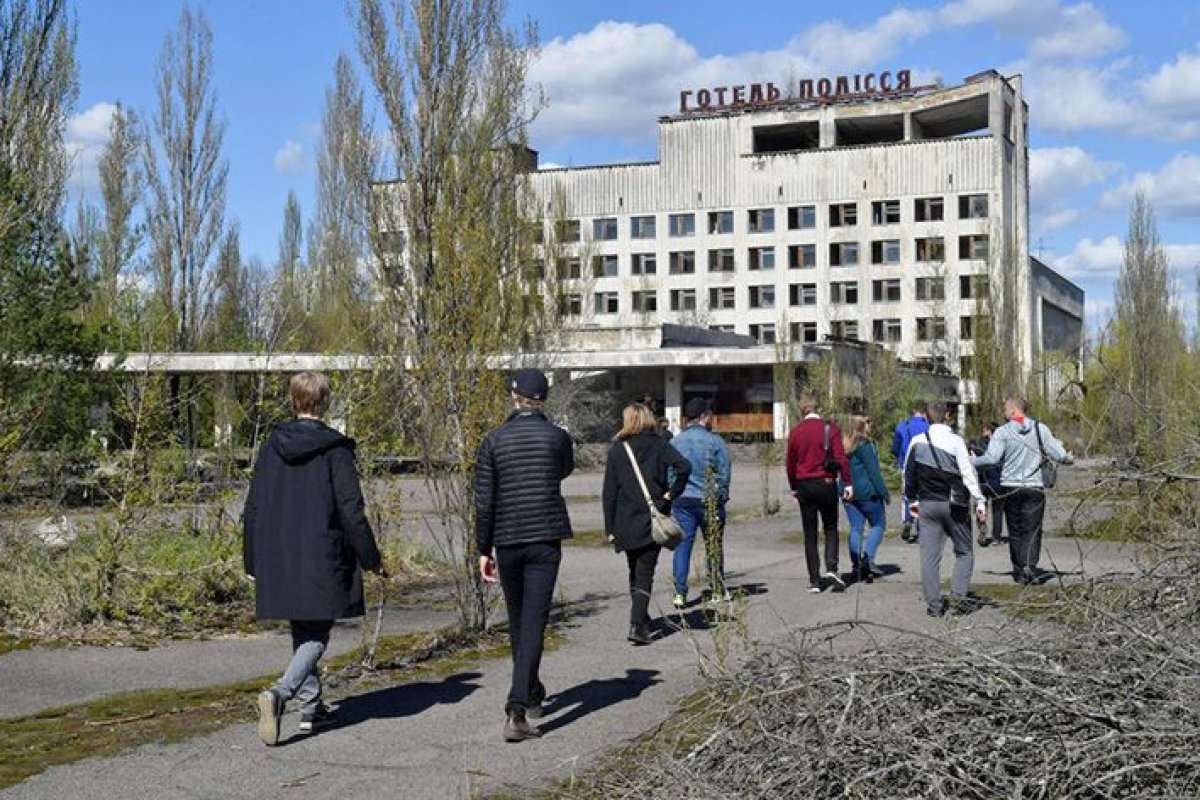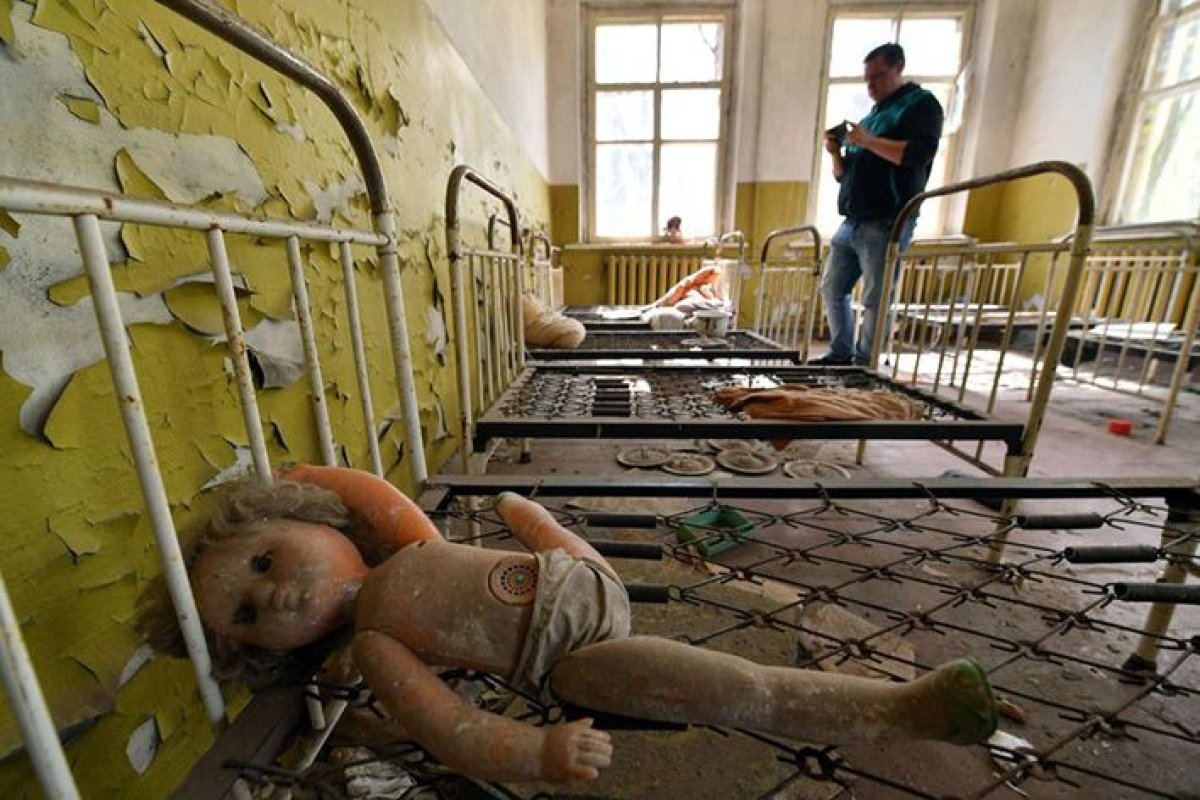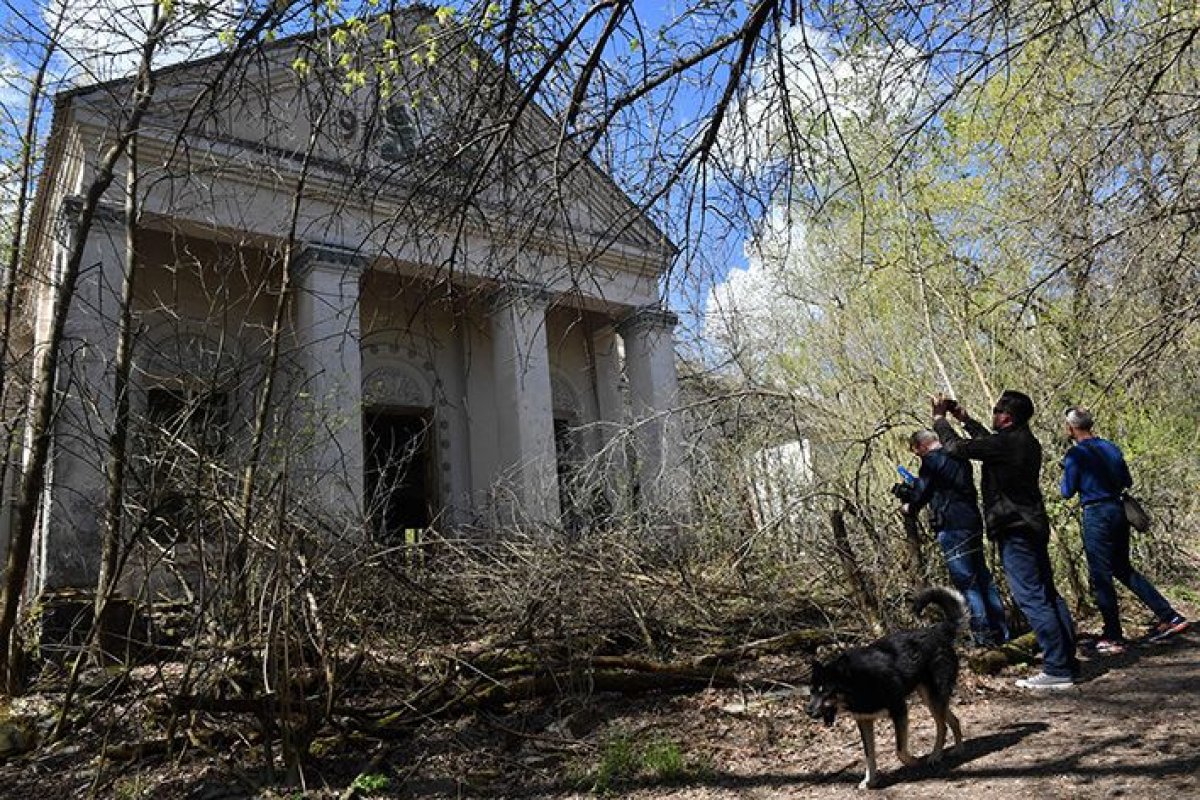Chernobyl has a flourishing tourism industry. At least 60,000 people visited the Chernobyl exclusion zone in Ukraine in 2017, according to official government data. Tourists from around the world wander around the exclusion zone with Geiger counters to measure radiation. They buy t-shirts and fridge magnets. Some even pay extra to spend the night. But this increased activity has locals and historians concerned about the memories behind the tragic site, home to the worst nuclear accident in human history.
Tourists entering the exclusion zone can only go on a supervised tour. People have to enter checkpoints as they exit to test for radiation. Still, tourists visiting the Ukrainian exclusion zone are told that a trip the region will expose them to less radiation than an overseas flight. Numerous tourists told Newsweek that they were told that flying would expose them to more radiation than visiting Chernobyl.

"We were reassured that it's very safe," Alex Shly, a Russian-Australian who visited Chernobyl while working on peace building projects in Ukraine, told Newsweek. "Our guide had a Geiger counter and would show us readings at different locations, including near reactor number four and near some 'peaks' on some of our stops. Hence, I didn't feel concerned for my safety at all since I realized that the guides and the people that work there are fine."
Kyle Logan, an American who was in the Peace Corps in Ukraine when he took a trip to Chernobyl, said that he didn't feel unsafe traveling to the exclusion zone because the tour guides seemed knowledgeable about how to avoid the dangers of radiation. In the car from Ukraine's capital Kiev to Chernobyl, the guides showed him a video describing the different levels of radiation and the best way to stay safe during the trip.
"Going out they have these old Soviet-style things and you have to put your hands on it to make sure that you aren't bringing out any radioactive material as souvenirs," Logan said. "The tour I did stressed that we generally shouldn't pick up anything, especially if you don't have gloves on. And it was actually better because I did it when there still was snow on the ground, and there is much lower radiation."
Tourists visiting the exclusion zone are asked not to wear shorts or open toed shoes. In fact, the more clothes you wear the better.

Juho Mikkonen, a resident of nearby Finland, took a week off from work in April to travel to Ukraine. During his visit, Mikkonen says that he noticed on Trip Adviser that it was possible to travel to Chernobyl.
"I found the tour by looking at 'things to do in Ukraine' on TripAdvisor," Mikkonen told Newsweek. "There were many selections available, so I chose the top rated day tour."
"After booking tickets there was an email sent to me with a list of basic advice about dressing, eating, and so on. The actual instructions were given on the tour," Mikkonen continued. "We spent about 30 minutes in a bus going through generic radiation safety instructions and rules about not sitting, putting your stuff on the ground during the tour, picking up items, illegal smuggling, mostly forbidden drone usage. Some information was already available on the organizer's website before the tour."
So far, none of the risks seem to be keeping tourists from visiting the exclusion zone. Some tourists, particularly rowdy groups of British men, have started traveling to Chernobyl for bachelor parties. Last year, the area hosted its first rave.
The video game Stalker, in which players shoot zombies, has a scene set in Chernobyl. Aficionados of the game often go on tours to visit the places where they killed zombies online.
Julie McDowall, an expert on nuclear war, visited Chernobyl in 2017 and was upset to find that many tourists were littering and that one "stalker" had recently died attempting to climb the Soviet-era radar the Duga in order to take a selfie.
"I loathe the crass and careless tourism which is springing up in Chernobyl. It is the site of an appalling disaster, and no place for selfies and superhero costumes," McDowall told Newsweek.
"I may sound arrogant in saying that, but there seems to be a disturbing rise in trashy tourism to Chernobyl," McDowall added. "And I mean that literally. Guides have been out collecting the litter left by tourists and the illegal stalkers. They gather it in black bin bags, but it can't be collected and disposed of in the usual way as it can't be removed from the zone…. My guide said when she brings groups here in summer she often urges her group to 'run!' if they want to snap a selfie in front of the [ferris] wheel, so her group is trying to outrun other groups, everyone dashing and squabbling to get a photo."

But Franka Hummels, a Dutch author and journalist who wrote a book about Chernobyl, said some tourists are driven by genuine nostalgia for a bygone era.
"I saw several types of tourists, but one of the main types of tourists was actually from the former Soviet Union. They have some kind of nostalgia because, of course, their country ceased to exist in 1991," Hummels told Newsweek. "In 1986, time stopped in Pripyat. So they go and are like, 'these curtains, we used to have these curtains, or these drawers or books.' For them it's really a trip down memory lane."
While Ukraine has undergone a formal process of "decommunization," which began in 2015 after Russian-backed separatists occupied the eastern part of the country, Pripyat and the area surrounding Chernobyl have avoided that fate. While statues of Soviet leader Vladimir Lenin have been ripped down across the country and communist symbols were outlawed, Chernobyl has remained frozen in time. The streets and architecture are unchanged since before the collapse of the Soviet Union, except for the wear and tear of time and the elements.
Juliet Jacques, a British author and filmmaker, decided to visit Chernobyl when she was staying in Ukraine's capital working on a movie.
"I thought I might as well go to Chernobyl because when else will I have the chance to go to a post-nuclear exclusion zone? I was thinking of it as this strange thing to do that I couldn't do anywhere else. I thought it would be an interesting thing to do and I completely underestimated the emotional impact it would have on me," Jacques told Newsweek. "If before I had gone thinking this will be an interesting experience, and not thinking about the emotional or ethical side much, you do think about it when you're there and wonder if it's right to go and look at these people's homes that were abandoned. We went to look at the hospital in Pripyat, which was of course extremely busy in the days following the disaster."
Jacques argues that keeping Pripyat unchanged makes it an attractive tourist destination, but there are also political and ideological reasons for keeping the area maintained like a time capsule.
"You get to the entrance of the town Chernobyl and there is a Soviet concrete sign with atoms and Soviet imagery and a statue of Lenin and all of that. It is quite strange to see it preserved," Jacques told Newsweek. "It serves a tourism function and an ideological function. It's saying this is where the Soviet projects ends up. Leaving the Soviet imagery in place serves a certain political function as well as an economic tourist one. In Pripyat it's particularly powerful. All of the windows are smashed from the inside out. Everything is in such a state of distress."
Uncommon Knowledge
Newsweek is committed to challenging conventional wisdom and finding connections in the search for common ground.
Newsweek is committed to challenging conventional wisdom and finding connections in the search for common ground.
About the writer
Cristina Maza is an award-winning journalist who has reported from countries such as Cambodia, Kyrgyzstan, India, Lithuania, Serbia, and Turkey. ... Read more
To read how Newsweek uses AI as a newsroom tool, Click here.








